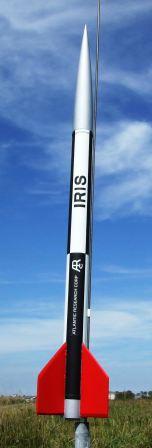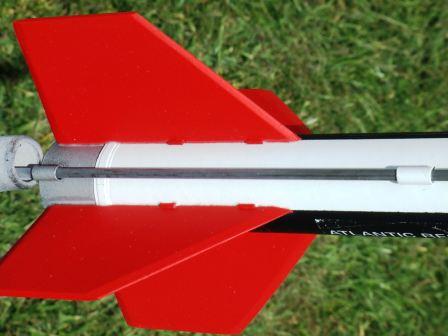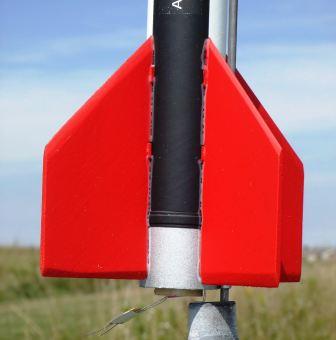| Construction Rating: | starstarstarstarstar_border |
| Flight Rating: | starstarstarstarstar |
| Overall Rating: | starstarstarstarstar_border |
| Diameter: | 1.17 inches |
| Length: | 23.80 inches |
| Manufacturer: | Semroc  |
| Skill Level: | 1 |
| Style: | Scale |

Brief:
The Iris is one of the first of a new sport scale line by Semroc called the Deci-Scale, each roughly 1/10th the size
of the real thing. This model is based upon the Atlantic Research Corporation's sounding rocket. The kit is just for
the upper stage, as the real sounding rocket flew off of different booster configurations, never on its own, so this
model would not qualify for entry in an NAR competition. Still, it is a cool looking rocket and a bit more complex a
build than the typical 3 or 4 fin fare that's the majority of the commercial rocketry fleet.
Construction:
Components are all excellent quality, as usual:
- Balsa nose cone (8 inches long, 1/3 of the total rocket length!)
- Series 11 body tube (1.17" OD)
- BT-20 motor tube
- Centering rings, motor block, metal hook
- Laser-cut balsa fins (4)
- Laser-cut fin mounts (8)
- Laser-cut tube bands (2)
- Kevlar®/elastic shock cord
- Plastic parachute
- Waterslide decals
While this is a relatively easy scale model, I'd probably rate the skill level a 2 on the 1-5 scale, simply because the paint/finishing pattern is a little tricky. I'd estimate I spent about 5 hours on this plus finishing, and the finishing was strung out over the better part of a week.
The instructions follow Semroc's newer format, designed to fit in a 3-ring binder which can be spread open while building. It struck me as a little hokey at first, but I have to admit with several hundred sets of kit instructions stuffed into a milk crate for a file, I'm starting to overflow a bit and using 3-ring binders is a pretty good idea. The instructions overall are about 3 letter-sized pages.
The motor mount is typical tube, block, metal hook and centering rings combo, with the Kevlar® shock cord anchored around the forward ring. Mark the body tube for 4-fin pattern using a template on the instruction page, then insert the completed motor mount assembly into the main body tube.
Prior to mounting the fins, though, comes a little scale realism. First, there's a nifty pair of wrap-around bands that just fit under cutouts in the fins. Pay careful attention to the instructions, as there's a glue side and a shiny/don't glue side. The bands are a very precise fit, so I went extremely thin on the glue so that they would make it all the way around twice--the first trip puts down a wide band, then the wrap gets narrower for the second trip around, for the smaller band. One of the bands goes under the fins (before bonding, of course)and the other goes flush with the forward end of the body tube.
The fins themselves get a couple small cardboard mounting plates tacked on underneath them, also in laser-cut notches. Realizing that the fins would be red, mounted on a line where white and black zones meet up, I felt that trying to mask and paint around the plates would be difficult, so I bonded them to the fins and painted the fins offline, mating up to the black/white/silver painted main body later.
The nose cones gets a screw eye anchor, and a pair of 1/8" lugs are tacked on, wrapping up construction. One note on lug placement, keeping the finish paint scheme in mind. There are 8 rectangles alternating black and white (2 rows of 4) on the main body tube. The lower black rectangles and upper white rectangles get decals in the middle, so you want to avoid these areas for lugs. That leaves half the body, but Murphy says if you don't plan it out up front, you'll find yourself trying to apply a beautiful scale decal around a lug.
Finishing:
As noted, I did a fair amount of the finishing before/during construction. For the main tube, with bands applied, I
applied a couple thin coats of gray primer, then 2 coats of gloss white, sanding after primer and finish coats. I then
drew 4 fin lines with a black Sharpie, which I then used for marking and masking off the rectangular regions, covering
up the white. I hit everything with 2 quick coats of gloss black, then masked off the body tube from the aft band
forward, shooting the lower section with silver.
The fins, as noted, were painted red offline then tacked onto the main body with CA, and really thin white glue fillets (applied with a syringe).
I had previously confirmed that the white on black Atlantic Research Corp decals were white ink, as opposed to clear printed on white-backed paper, so applying them over the black region was fine, though the gloss wasn't quite an exact match. The black Iris decals went on the upper white rectangles.
Construction Rating: 4 out of 5
Flight:
For the first flight, I had a chance to enjoy a magnificent late summer day at the field, winds around 6-8 mph,
temperatures a perfect 76, clear skies, etc. Since it was such a nice day for a walk, I put this up on a C6-5. It flew
straight as an arrow, though it seemed my delay was a hair longer than -5, so ejection was slightly past apogee, which
I estimated to be about 600-700 feet.
Recovery:
I certainly did have a bit of a walk, though not too bad. The 12" plastic chute brought it down at a modest but
not slow speed, and I recovered everything fine about 400 yards away.
Flight Rating: 5 out of 5
Summary:
Pros--nice scale detail, especially the fins, wraps, and black on white decals.
Cons--none.
Overall, this is a very good scale-like kit for the money.
Overall Rating: 4 out of 5
Other Reviews
- Semroc Iris By John "MAX" Venable (October 17, 2009)
Brief: This is another TIGHT repro from Semroc. Very Sleek and FAST.Semroc supplied me with a 24mm mount for free. Construction: The Kit consists of: 1 Balsa Nosecone, 1 Body tube, Motor tube, 4 Balsa fins, 1 screw eye, 1 thrust ring, chute pak, kevlar shock cord, launch lugs, engine hook, a set of decals. The only con about this Rocket is ...
- Semroc Iris By Ron Wirth (September 17, 2009)
Brief: Semroc has recently started a new line of Deci-ScaleTM rocket kits that are 1/10 semi-scale models of the originals. The IRIS is one of the first in the Deci-ScaleTM line which is a semi-scale model of the real Iris designed by Atlantic Research Corporation in the early 1960s. This model is a 4 fin rocket with some added details that give a true scale appearance to the ...
 |
 |
Flights
 |
 |